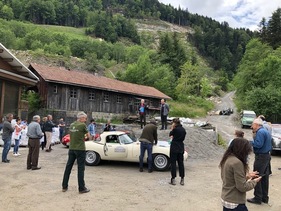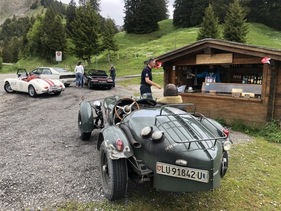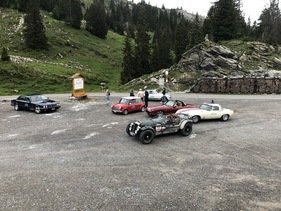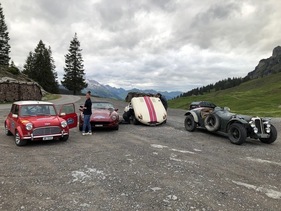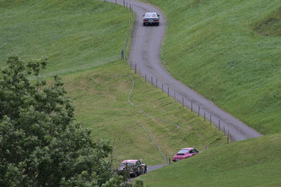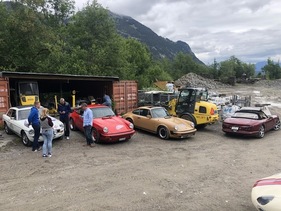The 18th Alpenbrevet was announced on the website as an "Alpenbrevet with a surprise". As a regular participant, I already knew that the 18th Alpenbrevet should not have taken place for reasons of piety. However, Georg announced on the occasion of the 17th Alpenbrevet in the Lingotto building in Turin that the ideal constellation of the full moon on June 5, 2020 and the mountain passes that were just opening up had prompted him to hold the 18th edition anyway - with a surprise.
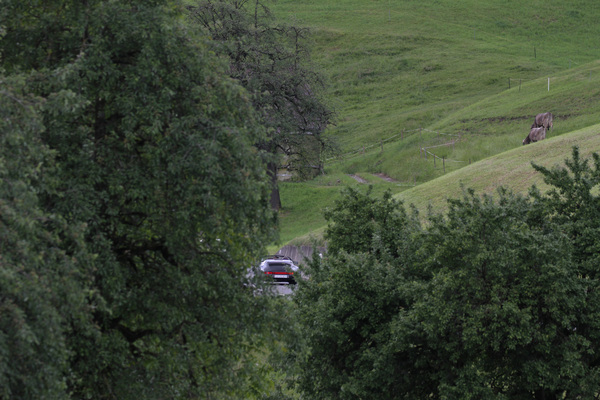
Two surprises at once
However, only a few experts in the world were able to predict the real surprise for 2020 - Corona.
I am actually a regular customer, although the chief organizer regularly fails to recognize me. His explanation that he only sees his participants briefly at the start and at the finish he is focused on evaluating the proof of passage should apply. As a regular customer, I registered back in October 2019 and immediately received a one-liner as confirmation of receipt. Then I didn't hear anything for a long time. Deep in lockdown, I contacted the Old Mill and dared to ask what was planned for the Alpenbrevet. I defiantly received the short answer: the Alpenbrevet was taking place, Covid-19 or not. I found this answer almost a little presumptuous, but "wait and see" as they say here.
And indeed, on April 28, 2020, the invoice arrived with the traditional participation fee. Three! Two! One! Zero! Zero! (i.e. CHF 321.00). Attached below is a text module with cryptic information such as: Corona, BAG (= "Federal Office of Public Health"), Hotel Giessbach, first Classic Car event worldwide in 2020, only 21 registered participants and no publicity. I wasn't surprised about the publicity, if you studied the FOPH rules carefully, gatherings were forbidden. I began to wonder how a FOPH-compliant event could be organized.
Up to that point, I had come to know the Alpenbrevet as an organization that was always shining with unconventional solutions. To achieve this, very big levers often had to be pulled with the help of other Alpenbrevet participants!
But standing up to the rigid regime of the FOPH was a completely different matter.
And so it came to pass, as I thought it would. Nothing more was heard about the Alpenbrevet. Radio silence. I had already faithfully reserved my hotel room at the historic Grandhotel Giessbach. Then, one week before the start, I suddenly received an email.
"Time slot: 13.00 - 13.45 Location: Lopperstrasse. Well, Lopperstrasse is long and where are 21 cars supposed to fit on this narrow road along Lake Alpnach? Luckily, I opened the appendix, which showed a roughly sketched "Kroki" on which small gravel spot along the road one had to gather. Apparently my favorite annual event was going to take place after all...
The big day
Precisely within the time window, I drove along the meandering Lopperstrasse towards Sarnen, and suddenly a white XJ6 S1 was parked conspicuously behind the fifth bend, as announced. The former apprentice and the young Dönni slipped us a leaf. A page of Chinese characters. At least it was a "road book" and no longer a hand-painted Kroki. In the spacious parking lot of Pilatusgetränke, I now knew for sure that the Alpenbrevet was taking place: Familiar faces, more and less martial classics from various eras. A proper barrel route had been set up, but this was poorly adhered to by the participants, who were committed to the principle of anarchy, although the route was clearly described in the road book.
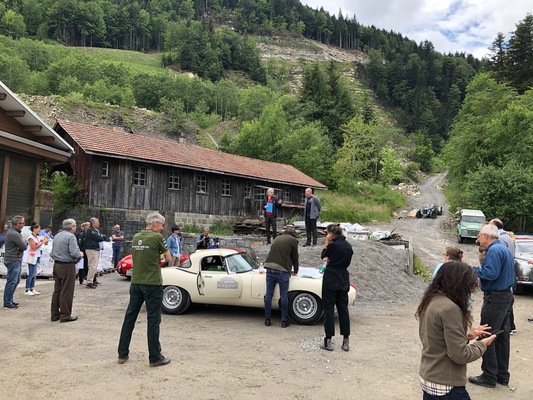
All the Alpenbrevet family members were involved in the Fassstrasse. The two founding wives and Markus handed out the rally documents at two meter intervals: The route description, a list of participants, the rally stickers, four liters of drinks, a box of Wernli "Guetsli", a pack of Darvida, an Argolite cup, a tomato saw and a labeled "Wurstbrättli".
While we were packing, Georg Dönni turned up with his Knatterwagen (XK 150 Special) and shouted a change of plan to us from the top of the retaining wall. The bridge was closed and we would have to take a different route to the Guber quarry.
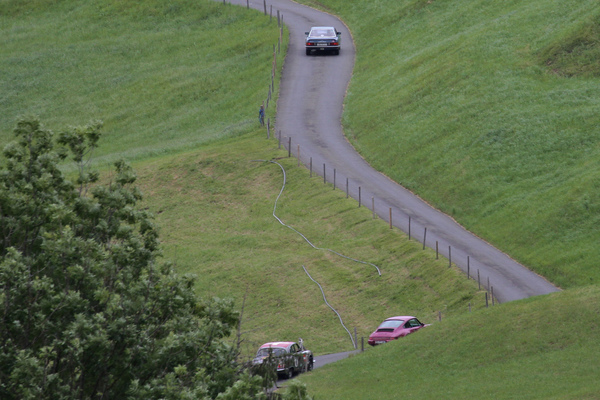
"Yes, because Gopfridstutz", couldn't anyone reconnoitre the route beforehand? It occurred to me that Balz once quoted the regulations: the organization is not allowed to reconnoitre the route. Should apply.
Well equipped
Now to the goodie bag: four liters of drinks, including two bottles of beer, even if it was non-alcoholic, which apparently necessitated many a stopover. The route description was a masterpiece of words and only four photos for the really difficult sections, well-intentioned but "tricky" to implement - we didn't even want to get lost.
A novelty was a sheet on which times and kilometers had to be entered, including a predetermined prologue with words like bread, sausage, cheese. What was that all about? The list of participants no longer comprised 21 cars, but 37, which somehow resulted in me only getting a large sticker, even though I had registered early.
Had the organization perhaps still admitted cars after the stickers had already been produced...? The organization was generous and overlooked such shortcomings. The Argolite cup was a good idea, but how are two people supposed to drink from the same cup in a Corona-friendly way? The Dönni tomato saw may be suitable for tomatoes. But it was probably less suitable for cutting a hard sausage or a rind, because you slipped and enriched your picnic with your own blood. Trivialities aside, back to the rally.
Impressive start
Despite the overcast sky, the view from the narrow, steeply ascending road to the Guberstein quarry was breathtaking. Lake Alpnach unfolded more and more and the menacing Lopperriegel fell closer and closer to eye level. When we arrived at the quarry, we had to follow the signpost to the BBZ der Schweizer Pflästerer. What a mess. Natural road, potholes, puddles - the corona-cleaned car was already "soaked" before the actual start. In the clearing behind the quarry, classic cars were scattered wildly, pretty to look at in their cheerful colors, not like today where everything is gray, black and white, quarry colors.
The caterer actually managed to cater for the coronavirus. Dried meat and cheese from our own cows, pasta salad, the legendary Alpenbrevet cold dish - reinterpreted each time, fruit and an Appenzeller Schlorziflade rounded off the lunch.
After Markus and Georg's admonitions, everyone was able to leave on time at 15:00. Now I understood the "surprise", because after a prologue, everyone was free to put together their own route until breakfast at 08:00 the following day.
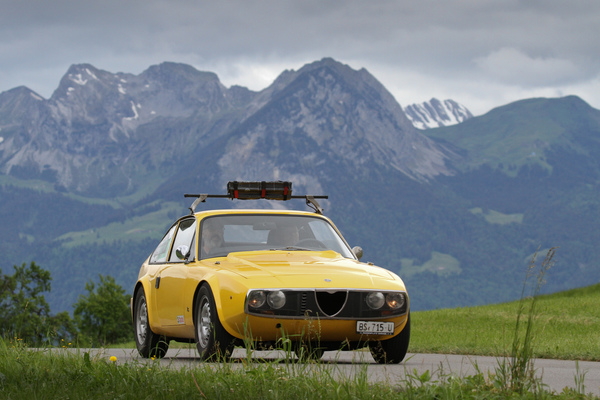
The function of the prologue was to put together your own picnic, as it was too hot even for the Alpenbrevet organization to hold a midnight meal somewhere in the farthest Calanca valley in a cramped alpine hut with 80 people. So they collected bread from a bakery on the way, Sprinz and Alpine cheese from a cheese dairy and Aelpler sausages on the Glaubenbühlen Pass. Now it was also clear why they had been given eight bottles of drinks on the way. You should have a picnic on the way. This was interpreted in many different ways.
Very relaxed participants went for a fine meal or went to the castle in Attishausen to eat a Güggeli in the Chörbli. Most, however, obeyed and found more or less cozy places in the deep night for refreshment on the long journey.
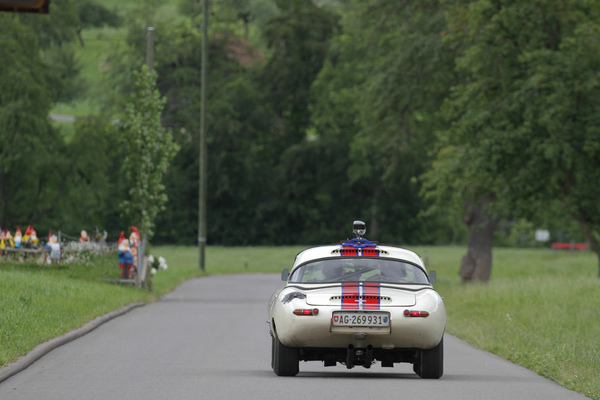
The difficult-to-interpret prologue route from Sachseln via Hohe Brücke to Ächerlistrasse was worth it for the beautiful views of the Obwalden region alone. After the Ächerli Pass, which could not be approached too early as otherwise the road would be closed due to construction work, you were free to ride the Pragel Pass or the Klausen Pass first. As the ferry didn't leave until the following day, we were forced to drive through the Seelisberg tunnel. However, one team found it dishonorable to take the freeway, as their Fiat 127 had been built before the Seelisberg tunnel was built, and so the crew bravely crossed Lucerne in the evening traffic.
Collecting passes through the night
On the way, the first pass riders met up with the first pass riders, a bit like the counter-march at Sechseläuten. Night slowly fell for most of the participants. Now the actual Alpine brevet began: almost all participants decided to ride in the Gotthard massif. Only the Susten was still closed, all the other passes were open. If you came across yellowish lights, you could be sure that it was a colleague who was not yet driving with xenon lights.

Some participants equipped their cars with extra-bright LED spotlights. However, this caused all kinds of problems. The spotlights wobbled too much, they illuminated the hood from the roof so strongly that it began to dazzle, they illuminated the surroundings so strongly that you were dazzled after dimming, so I praised my "little candles" which, together with the very large and bright moon this time, illuminated the road excellently.

If you're like the Alpine brevet enthusiasts, then night riding is simply addictive. Driving your historic automobile on empty mountain passes in the silver moonlight without any spoilers. Alone, completely alone ... except for the fauna of the Alps. This year I only saw one marmot.
The most impressive sighting was undoubtedly a multitudinous stag. It majestically tried to dominate the southern ramp of the Novena and was reluctant to leave the road, as participants told me. But there were also hinds, a herd of chamois and even an ibex crossing the occasional headlight beam.
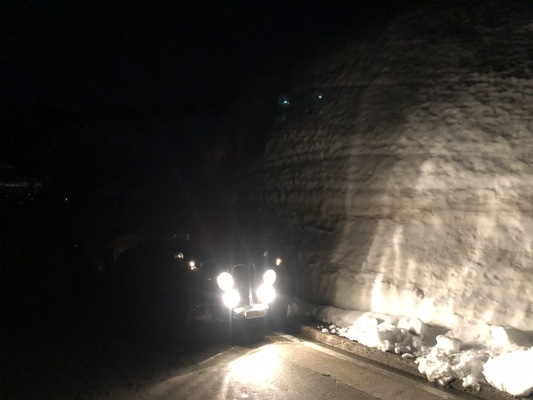
With such sightings, the two foxes fell into the "distant background" and the cows on the road are not worth mentioning in this context.
Arrival
Amazingly fit, I reached the Giessbach Hotel at 06.30. I was amazed to see many of the participants' cars already parked in the parking lot. After an invigorating walk to the historic hotel, I was warmly greeted by relaxed fellow participants. Simone made sure I had a warming coffee and other participants finished off their day's work with an after-work beer.
Breakfast was served at 07.00 and the organization team began to evaluate the control sheets and distribute the trophies. Here is another specialty: the trophy is a crystal from the Gotthard massif, be it a rock crystal or a smoky quartz, mounted on a polished slab of Gotthard serpentine. Depending on their performance, the participant was awarded a gold, silver or bronze plaque with the year "2020" after a sympathetic evaluation.
The hard core usually "stayed overnight", but my family called after me, so after breakfast I made my way home, not without promising my colleagues and friends that I would take part again next year. Perhaps Georg Dönni will then recognize me as a regular customer?
P.S. We would like to thank some of the participants for sending us photos, some of which have been included in the report!



















































































